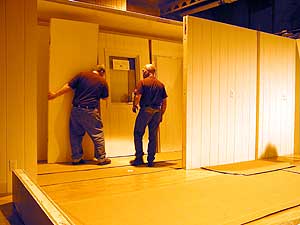|
Audio
Photos
Resources
|
April 25, 2005
 |
| A crew of eight took one hour to build the house. There's no expertise required. Developers say it's similar to building unassembled furniture. (MPR Photo/Bob Kelleher) |
Duluth, Minn. — They were building a house at the Natural Resources Research Institute in Duluth, and it only took one hour. The house is a new design intended for quick and sturdy emergency or temporary housing. NRRI's Pat Donahue says the idea isn't just about housing.
"What we're trying to do here is create not just rapid response housing, but really the core of what we're trying to do is create an industrial base," Donahue says.
It starts as a standard-sized 8 by 20 foot shipping container, and turns into a small one story home about three times that size, with two bedrooms; a bathroom and shower; a kitchen with appliances; and storage. The mock-up is spartan. At first glance it looks like a rustic lake cabin or a nice hunting shack. It's a big step up from sleeping outdoors.
The designers call it temporary, but it is built to last, and could last as long as a conventional home. It's also designed to be taken down and re-used many, many times.
Donahue says the key is closed wall construction. Wall panels come complete with wiring, plumbing, windows and doors, all finished inside and out. The floor comes in three sections; the roof in long panels that peak slightly in the middle. It almost snaps together like a giant toy.
Donahue says the house is getting a hard look by potential customers, including one building a large natural gas pipeline across northern Canada.
"They need to house 11,000 employees, and they need to move the houses as the pipeline is being produced," says Donahue. "And because of some of our techniques, and the ability to disassemble it and reassemble it very quickly, they thought our idea had a lot of merit."
House parts are provided by mostly northern Minnesota companies, using regional wood and wood products. Donahue says there's a huge potential for Minnesota products and jobs.
"This is a definite wave moving forward, and I think it can create hundreds of jobs," says Donahue. "Not just for an assembly plant, but I think it can create a lot of peripheral jobs. I think we found that to build this successfully we're going to need about 60 vendors, and all of those are local people."
Jerry Birchem's company built the wall panels. Aurora Building Systems is a relatively new company specializing in pre-built panels for new construction.
"The way it's going to be, it's going together, is each person - each business - makes up a part of it, where not one business is going to make the whole house," Birchem says. "We provide the panel. Somebody else provides the floor. Somebody else does the roof. So everybody's efficient in what they do."
The little homes could be a low cost alternative for recreational housing, like lake homes or hunting cabins. The 480 square foot prototype would likely sell in the range of $24,000 to $25,000. Costs would vary for local codes and applications. There's potential of using the homes in disaster situations, as temporary housing that can be stored, assembled, and disassembled when no longer needed.
Rick Klugow is an Emergency Programs Specialist with the Federal Emergency Management Agency out of Chicago. They're the ones who help people out when a disaster like a flood or hurricane leaves them homeless.
"We're here, basically, for a little fact-finding," Klugow says. "To find out what the product is, if it has some application in disaster situations, making sure that it meets all necessary codes and safety, and I'd like to be able to see that it could be reused to save the taxpayers some money."
NRRI has just received a private grant to build a second prototype. There are a few details to work out, and some new design ideas. Meanwhile, there are a half dozen area companies interested in becoming the first assembly plant. That could happen, according to NRRI's Pat Donahue, as soon as the first big customer steps forward.







